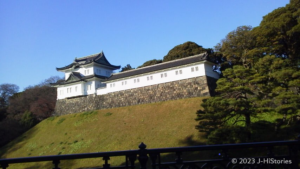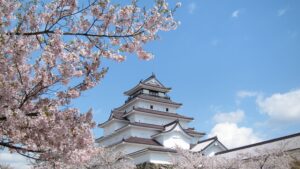Takayama Festival (Spring and Autumn), Keep your eyes on Karakuri doll’s performance
In Spring, the Karakuri doll scatters a lot of cherry blossoms to commemorate the arrival of spring. In Autumn, one small Karakuri doll moves by hanging and moving across several bars one by one riding piggyback on the Hotei, who is known as a deity of good luck. People watch its success breathlessly. Once it makes it, loud cheers erupt. It’s held in the center of Takayama city in Gifu prefecture twice a year after the crops in spring (April 14-15) and after the harvest in autumn (October 9-10). Several large ornate floats called “Yatai” are drawn around the center of the town by people in traditional kimonos and hakama (traditional Japanese pants). In front of the shrine, these Yatais are lined up and the Karakuri dolls on the floats perform subtle and impressive movements in dedication to the deities of the shrine.
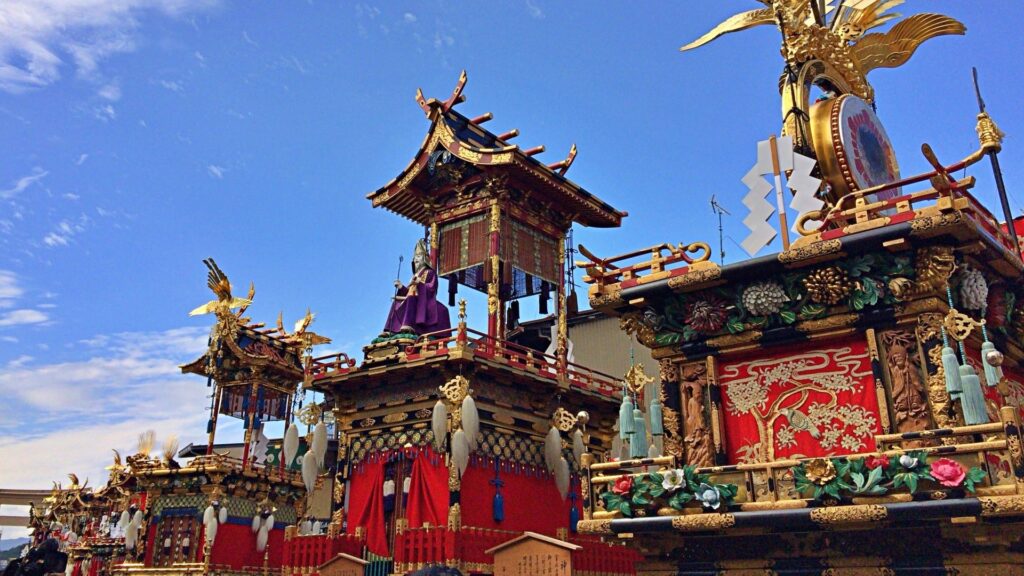
Yama, Hoko, Yatai, float festivals in Japan, UNESCO Cultural Heritage
Takayama Festival (高山祭り) is one of the three most beautiful festivals in Japan along with the Gion Festival (祇園祭) in Kyoto and the Chichibu-Yoi Festival (秩父宵祭) in Saitama prefecture. 33 festivals including the above three were inducted into UNESCO’s Cultural Heritage list in 2016 as “Yama, Hoko, Yatai, float festivals in Japan“. About 1/3 of the 33 on the list, the 11 festivals are in the Tokai region, which includes Takayama in Gifu Prefecture, Tsushima Tenno Festival (尾張津島天王祭), Chiryu Festival (知立の山車文楽とからくり), and Inuyama Festival (犬山祭) in Aichi Prefecture, all of which have long been active in the tradition of "Dashi Karakuri".
Tsushima Tenno Festival
The Tsushima Festival is a ritual festival called "Goryoe" that is held to repose the spirits of the deceased. In the evening, several boats are set out on the river, each one decorated with 365 lanterns arranged in a semicircle. The following morning, boats carrying Noh puppets row out to the river while music is played. This festival has been held for over 600 years.
Chiryu Festival
The Chiryu Festival is a ritual festival of the Chiryu Shrine that began in the Edo period. It is characterized by the performance of the float ”Bunraku" (a Japanese puppet show) on the floats. In particular, the performance of the Karakuri doll requires advanced string manipulation techniques.
Inuyama Festival
The Inuyama Festival is an annual ritual festival held at the Haritsuna Shrine. Around 40 Karakuri dolls dance on 13 floats during the festival amidst a beautiful display of cherry blossoms, accompanied by festival music. The event is a celebration of both the Karakuri dolls and the people who enjoy them in the present day.
A Karakuri doll is "Himorogi" (a sacred object) upon which "Kami" dwells
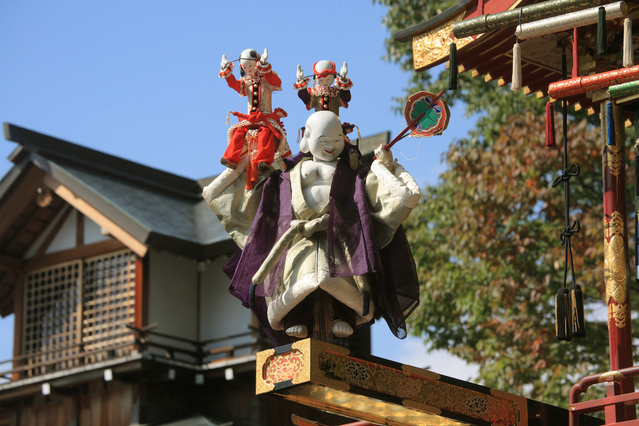
Since ancient days, people have been in awe of various deities called "Kami", such as the Kami of the harvest, "Kami" of rice, and so on as spiritual beings that possess supernatural power beyond human understanding. People welcome Kami, make offerings, and express gratitude to Kami. This is the origin of "Matsuri" (Shinto festival). People believed that deities’ spirits come down to these karakuri dolls to be considered “Yorishiro” (an object that divine spirits are drawn). It’s said that the first Karakuri doll in Japan was produced in 658 as a deity’s Yorishiro and it evolved. Karakuri technology has been combined with dolls, which are the object of worship, and various types of ”Karakuri dolls” have been developed to make the festival more attractive.
Evolving Karakuri dolls by the Spanish clock's advanced technologies and Japanese craftsmanship

Around the 17th century by applying several technologies such as gears, coil springs, cams, and strings were based on several imported Western things such as clockwork table clock. The first advanced clock was presented to Tokugawa Ieyasu (1543-1616, 徳川家康), the first Shogun of the Tokugawa Shogunate by the King of Spain, Felipe the Third in 1611 expressing Spanish thanks for Tokugawa’s rescuing Spanish shipwrecked people off the Kazusa coast in Chiba prefecture. After that, the Karakuri doll was developed into a more elaborate one with Japanese craftsman’s originality and ingenuity. It was gaining popularity among people attending festivals and fairs.
In 1620, Karakuri dolls of "Ushiwaka and Benkei" were put on floats first at the Nagoya Toshogu Festival in Nagoya city. Then, floats with Karakuri dolls called “Dashi Floats” became popular mainly in Aichi and Gifu prefectures. The 7th federal lord of Owari domain, the center of which was in Nagoya, Tokugawa Muneharu(1696-1764, 徳川宗春;) invited many doll craftsmen who suffered from lack of work due to the policy of simple and frugal life led by the 8th Shogun, Tokugawa Yoshimune (1684-1751, 徳川吉宗). Here Owari domain triggered the Karakuri doll’s development and manufacturing.
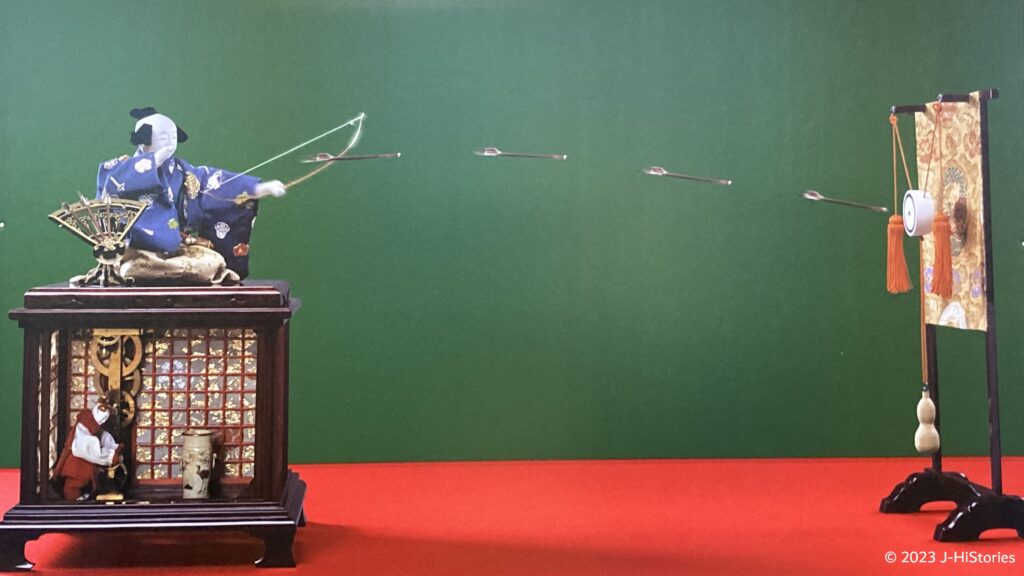
Later in 1851, Tanaka Hisashige (1799-1881, 田中久重) known well as Karakuri Giemon created a breakthrough masterpiece of a Japanese perpetual clock called "Mannen Jimeisho”, which moved automatically for more than 200 days once its spring was wound. It was more than just a clock also it displayed 24 seasons, seven luminaries, a calendar, and phases of the moon through his creation of a unique and advanced gear called "mushi-haguruma”, which enabled one to adjust the period accordingly. He created several Karakuri dolls as well. The most famous one was “Yumihiki-Doji”, a child Karakuri doll that draws four bows one by one and hits a target several meters away. Occasionally, some arrows were deliberately made to miss the target to warm up the show. People enjoyed this spectacle.
SDGs by Karakuri Technologies
In modern days, Aichi and Gifu prefectures area bloomed modern manufacturing technologies such as spinning industries in Gifu and Automotive industries in Aichi, probably because of the existence of many Karkuri craftsmen there. Recently, Karakuri technologies such as gears and simple mechanisms are gaining momentum to improve the manufacturing process at plants utilizing natural energy like gravity. "Kami" might dwell in the manufacturing plants as well. Please enjoy watching several amazing Karakuri performances at the Takayama Festival and other several festivals in this region with the “Central Japan, Dashi Floats Festival map” in your hand. The perfection down to the finest detail and the exquisite finish of Japanese craftsmanship has contributed a lot to these areas and also Japan’s manufacturing and industrialization.
Recommendations to visit
Takayama Festival
- Access: 2 hours from Nagoya station bound for Takayama on Takayama main line
Tsushima Tenno Festival
- Access: 30 minutes from Meitetsu Nagoya station. Take the train on the main line bound for Saya (佐屋) and get off at Sukaguchi (須ヶ口) station. Transfer to the Tsushima line bound for Yatomi (弥冨), then get off at Tsushima (津島) station. A 15-minute walk to Tsushima Shrine
Chiryu Festival
- Access: 20 minutes from Meitetsu Nagoya Station on the Meitetsu main line bound for Toyohashi (豊橋). Get off at Ciryu Station (知立). A 15-minute walk to Ciryu Shrine.
Inuyama Festival
- Access: 30 minutes from Meitetsu Nagoya Station to Inuyama. A 15-minute walk to Harigane Shrine.

